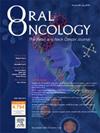Surgical, Functional, and oncological outcomes of transoral robotic surgery for cT1-T3 supraglottic laryngeal Cancers: A systematic review
IF 4
2区 医学
Q1 DENTISTRY, ORAL SURGERY & MEDICINE
引用次数: 0
Abstract
Background
This systematic review investigated the surgical, functional, and oncological outcomes of transoral robotic supraglottic laryngectomy (TORS-SGL) for cT1-T3 laryngeal squamous cell carcinoma (LSCC).
Methods
Two investigators conducted an updated PubMed, Scopus, and Cochrane Library systematic review for studies investigating the surgical, functional, and oncological outcomes of TORS-SGL using the PRISMA statements. The bias analysis was conducted with the MINORS.
Results
Twenty-one studies were included, accounting for 896 patients. TORS-SGL was primarily performed for cT1 (39.1 %), cT2 (46.9 %), and some selected cT3 (7.7 %) LSCCs. Surgical margins were positive in 10.8 % of cases. The mean hospital stay was 8.6 days. Hemorrhage (6.3 %), pneumonia (5.5 %), and aspiration (1.7 %) are the primary complications. The surgical margins were positive in 10.6 % of cases. Feeding tubes, temporary tracheotomy, and definitive percutaneous gastrostomy are found in 65.6 %, 19.7 %, and 5.2 % of patients, respectively. The oral diet is restarted after a mean of 7.2 days. The 5-year OS and DFS of TORS-SGL were estimated to be 78.3 %, and 91.7 %, with 5-year local-relapse-free survival and nodal-relapse-free survival of 90.8 %, and 86.6 %, respectively.
Conclusion
The TORS-SGL is a safe, and effective surgical approach for cT1-T3 SGL. The functional and surgical outcomes appear comparable with TOLM-SGL. The oncological outcomes of TORS-SGL could be better than TOLM and open SGLs, but further large cohort-controlled studies are needed to draw reliable conclusions.
经口机器人手术治疗 cT1-T3 声门上型喉癌的手术、功能和肿瘤效果:系统性综述
背景:本系统综述调查了经口机器人声门上喉切除术(TORS-SGL)治疗 cT1-T3 喉鳞状细胞癌(LSCC)的手术、功能和肿瘤学结果:两名研究人员采用 PRISMA 声明对 PubMed、Scopus 和 Cochrane 图书馆中有关 TORS-SGL 手术、功能和肿瘤效果的研究进行了更新的系统综述。结果:结果:共纳入 21 项研究,涉及 896 名患者。TORS-SGL主要针对cT1(39.1%)、cT2(46.9%)和部分cT3(7.7%)LSCC。10.8%的病例手术边缘呈阳性。平均住院时间为 8.6 天。出血(6.3%)、肺炎(5.5%)和吸入(1.7%)是主要并发症。10.6%的病例手术边缘呈阳性。分别有 65.6%、19.7% 和 5.2% 的患者使用了喂食管、临时气管切开术和最终经皮胃造瘘术。平均 7.2 天后重新开始口服饮食。TORS-SGL的5年OS和DFS估计分别为78.3%和91.7%,5年无局部复发生存率和无结节复发生存率分别为90.8%和86.6%:结论:TORS-SGL 是治疗 cT1-T3 SGL 的一种安全有效的手术方法。其功能和手术效果与 TOLM-SGL 相当。TORS-SGL 的肿瘤治疗效果可能优于 TOLM 和开放式 SGL,但要得出可靠的结论,还需要进一步的大型队列对照研究。
本文章由计算机程序翻译,如有差异,请以英文原文为准。
求助全文
约1分钟内获得全文
求助全文
来源期刊

Oral oncology
医学-牙科与口腔外科
CiteScore
8.70
自引率
10.40%
发文量
505
审稿时长
20 days
期刊介绍:
Oral Oncology is an international interdisciplinary journal which publishes high quality original research, clinical trials and review articles, editorials, and commentaries relating to the etiopathogenesis, epidemiology, prevention, clinical features, diagnosis, treatment and management of patients with neoplasms in the head and neck.
Oral Oncology is of interest to head and neck surgeons, radiation and medical oncologists, maxillo-facial surgeons, oto-rhino-laryngologists, plastic surgeons, pathologists, scientists, oral medical specialists, special care dentists, dental care professionals, general dental practitioners, public health physicians, palliative care physicians, nurses, radiologists, radiographers, dieticians, occupational therapists, speech and language therapists, nutritionists, clinical and health psychologists and counselors, professionals in end of life care, as well as others interested in these fields.
 求助内容:
求助内容: 应助结果提醒方式:
应助结果提醒方式:


